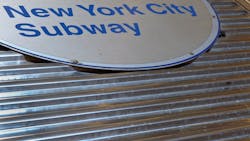NYCT piloting netting under elevated structures
Four locations under New York City Transit elevated structures will have netting installed as part of a pilot project to determine if the material not only catches potential hazards, but also allows regular inspections of the structure.
The netting used in the pilot is designed to capture items as small as a three-quarter inch bolt while retaining enough transparency to allow regular visual inspections of the elevated tracks – a key requirement to prevent this solution from introducing a new safety challenge or risk.
“We take reports of fallen debris from our elevated structures very seriously, because the condition of these structures is critical to safe train service and the safety of our neighbors,” said NYC Transit President Andy Byford. “We are encouraged by the possible viability and off-the-shelf availability of this netting to provide peace of mind to those who traverse streets below our tracks, and will continue our rigorous inspections of these structures, which are often struck by vehicles and exposed to highly varying conditions year-round that can speed deterioration.”
Several NYC Transit subway lines operate on elevated structures for some of their routes throughout the system, partly due to the hard bedrock upon which New York City was built. New York City Transit explains that while these structures remain safe for train operation, extreme weather conditions and over-height vehicle strikes that can damage the steel structure, tracks and sensitive operating equipment such as signals. To ensure safe operating conditions, NYC Transit conducts regular track inspections weekly, as well as visual inspections of tracks from the street level monthly and comprehensive visual inspections of the steel structures annually.
The testing locations were selected by NYC Transit engineers based on the results of these inspections, identifying two century-old elevated stations and two sections of elevated tracks on curves, which endure higher levels of stress and wear-and-tear from trains. The netting will be approximately 600 feet long and 50 feet wide, for a total of 30,000- square feet of coverage at each location. Altogether, the netting pilot will provide approximately 120,000- square feet of coverage at the four locations.
The four locations where the netting will be tested include:
The 61 St-Woodside station on the Flushing 7 line and the 125 St station on the Broadway 1 line were chosen due to a history of loose debris and their higher elevations. The 61 St-Woodside station, which opened in 1917, is located above Roosevelt Avenue, a main thoroughfare for trucks and other large vehicles, as well as a street-level Long Island Rail Road station. Owing to its age and exposure to weather conditions year-round, this location is particularly susceptible to deterioration that may cause debris to periodically fall from the structure.
Construction for the elevated track structure at 125 St began in 1900 and the station opened for service in 1904, making it one of the oldest elevated stations in the system. Netting will be installed under the station, which was built unusually high to maintain a level structure given the deep valley geography of Upper Manhattan.
The two other locations identified by transit engineers are below the Jamaica J-Z line’s elevated structure between 121st Street and 111th Street, and below the elevated structure on the Astoria N-W line between the Queens Borough Plaza and 39 Av stations. Both locations were chosen due to the curvature of the tracks and the condition of the structures.
A $2 million contract for the netting on the Flushing 7 line and the Jamaica J-Z line locations was awarded on July 5 to FOS. A second contract for approximately $2.6 million will be awarded at a later date, with installation scheduled to begin later this summer.
About the Author

Mischa Wanek-Libman
Group Editorial Director
Mischa Wanek-Libman is director of communications with Transdev North America. She has more than 20 years of experience working in the transportation industry covering construction projects, engineering challenges, transit and rail operations and best practices.
Wanek-Libman has held top editorial positions at freight rail and public transportation business-to-business publications including as editor-in-chief and editorial director of Mass Transit from 2018-2024. She has been recognized for editorial excellence through her individual work, as well as for collaborative content.
She is an active member of the American Public Transportation Association's Marketing and Communications Committee and served 14 years as a Board Observer on the National Railroad Construction and Maintenance Association (NRC) Board of Directors.
She is a graduate of Drake University in Des Moines, Iowa, where she earned a Bachelor of Arts degree in Journalism and Mass Communication.
